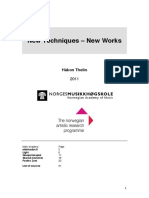Arnold Schoenberg: TH TH
Arnold Schoenberg: TH TH
Uploaded by
9름Copyright:
Available Formats
Arnold Schoenberg: TH TH
Arnold Schoenberg: TH TH
Uploaded by
9름Original Title
Copyright
Available Formats
Share this document
Did you find this document useful?
Is this content inappropriate?
Copyright:
Available Formats
Arnold Schoenberg: TH TH
Arnold Schoenberg: TH TH
Uploaded by
9름Copyright:
Available Formats
Arnold Schoenberg
Arnold Schoenberg’s pieces were extremely innovative and influential during
the 20th century and created expressionist music in the 20th century. The
expressionism in music heavily revolved around certain elements such as
atonality and dissonance which Arnold Schoenberg fully utilised. Tonality is the
system of keys and key relations and it took centuries in the western system to
develop and define. The key to tonality is to have the same home key for the
starting chord and the finishing chord and is theorised as an important element
of “pleasant” sounds. Schoenberg intentionally completely disregards tonality
in his music pieces to create impact. One of his famous expressionist pieces is
Peripetie.
The melody of Peripetie is disjunct and effectively uses all twelve pitches. The
rhythm is complex and irregular with regular cross-rhythms. the dynamic range
of the piece is wide and spans ppp-fff. The texture is constantly changing
throughout the piece. While the piece is largely contrapuntal, there are also
homophonic and monophonic sections. The piece holds a high level of
dissonance, this is explained by François-Joseph Fétis who theorises tonality is
the key to the pleasantness of a melody. The piece is also extremely chromatic
which means it does not fit into a particular scale or mode as it is not
composed upon a seven-note diatonic scale. the irregular rhythms and
contrasting textures help the piece to be labelled with angular melody.
Likewise to Stravinsky, Arnold Schoenberg uses a wide range of pitches and
leans towards the extreme pitches of different instruments.
This new and innovative style of music led to the path of expressionism in
music where him and his students explore and play with the different elements
of music.
You might also like
- Analysis of LebenslustDocument9 pagesAnalysis of Lebenslustchloe.peterson100% (1)
- Frédéric Chopin: The Etudes: History, Performance, InterpretationFrom EverandFrédéric Chopin: The Etudes: History, Performance, InterpretationRating: 4.5 out of 5 stars4.5/5 (6)
- Learning Activity Sheets in Mapeh 10Document18 pagesLearning Activity Sheets in Mapeh 10Badeth Ablao91% (22)
- Spring Extension Lab ReportDocument6 pagesSpring Extension Lab Report9름100% (1)
- DipABRSM Programme NotesDocument5 pagesDipABRSM Programme Notesmpbhyxforever33% (3)
- Orff Method: Teaching Strategies in Teaching Music To ChildrenDocument28 pagesOrff Method: Teaching Strategies in Teaching Music To ChildrenLeann Victoriano100% (1)
- CAGE, J. - Flute Works (Complete), Vol. 1 (Zenz)Document8 pagesCAGE, J. - Flute Works (Complete), Vol. 1 (Zenz)Fernando BarbosaNo ratings yet
- Impressionism Vs ExpressionismDocument2 pagesImpressionism Vs ExpressionismSidney CoNo ratings yet
- 윤이상Document4 pages윤이상Jin NamNo ratings yet
- Elizabeth Makharinsky Dec 12/jan 13 Exeter CollegeDocument7 pagesElizabeth Makharinsky Dec 12/jan 13 Exeter CollegemakharinskyNo ratings yet
- ExpressionismDocument10 pagesExpressionismtwvz77jmxmNo ratings yet
- Q1 Music10 Mod3Document11 pagesQ1 Music10 Mod3Dan DanNo ratings yet
- Teaching Guide Area of Study 1 (The Piano Music of Chopin Brahms and Grieg)Document41 pagesTeaching Guide Area of Study 1 (The Piano Music of Chopin Brahms and Grieg)Quinton Chu Lok SangNo ratings yet
- Frederick ChopinsDocument2 pagesFrederick Chopinsrouyang0422No ratings yet
- Piano Spheres Program NotesDocument2 pagesPiano Spheres Program NotesAndreas Foivos ApostolouNo ratings yet
- Impressionism and Expressionism Music (20th Century Music)Document18 pagesImpressionism and Expressionism Music (20th Century Music)Rey Fernand Cabailo50% (2)
- An Introduction To 20th Century Art MusicDocument3 pagesAn Introduction To 20th Century Art MusiccdjrhsNo ratings yet
- Antipolo National High School MAPEH Grade 10 SY 2021-2022 Music Quarter 1Document4 pagesAntipolo National High School MAPEH Grade 10 SY 2021-2022 Music Quarter 1maxpeinNo ratings yet
- Activity Sheets g10Document38 pagesActivity Sheets g10Lanie BatoyNo ratings yet
- PROGRAMDocument5 pagesPROGRAMZofia NeugebauerNo ratings yet
- Music 10Document63 pagesMusic 10Zaira Mae Valdez ErandioNo ratings yet
- GoodDocument1 pageGoodTariq Ahmed BalochNo ratings yet
- Day 15 Notes Chopin & Mendelssohn June 2020Document5 pagesDay 15 Notes Chopin & Mendelssohn June 2020WenlongShaoNo ratings yet
- Lesson 1Document26 pagesLesson 1Cindy Claire Dejolde VegaNo ratings yet
- Impressionism Made Use of TheDocument7 pagesImpressionism Made Use of TheClarissa Jessica Gala - LandichoNo ratings yet
- 20th Century Music G10 Copy 1Document87 pages20th Century Music G10 Copy 1Kylie MontefalcoNo ratings yet
- We in Music Are Like Physicists: TH THDocument5 pagesWe in Music Are Like Physicists: TH THTomCafezNo ratings yet
- Compositional Process in Arnold Schoenberg's Variations For OrchestraDocument11 pagesCompositional Process in Arnold Schoenberg's Variations For OrchestraMichael CrawfordNo ratings yet
- Serialism: Ramon P. Santos National Artist For Music (2014)Document2 pagesSerialism: Ramon P. Santos National Artist For Music (2014)Spcs Senior HighNo ratings yet
- Music Quarter 1Document25 pagesMusic Quarter 1Rocelgie JimenezNo ratings yet
- ExpressionismDocument15 pagesExpressionismEmily T. NonatoNo ratings yet
- Vocal Music of The Romantic Period Art Song and Opera q4 l1 For StudentsDocument8 pagesVocal Music of The Romantic Period Art Song and Opera q4 l1 For StudentscuetoblissnicoleNo ratings yet
- Bishop Tonnos Catholic Secondary SchoolDocument8 pagesBishop Tonnos Catholic Secondary SchoolAlicia JoyNo ratings yet
- Program Notes: 1. 2 Preludes by A. Scriabin (Arr: A. Fougeray)Document3 pagesProgram Notes: 1. 2 Preludes by A. Scriabin (Arr: A. Fougeray)AlmeidaNo ratings yet
- Module 2 (Music) Grade 10Document9 pagesModule 2 (Music) Grade 10mary janeNo ratings yet
- Module 2 (Music) Grade 10Document9 pagesModule 2 (Music) Grade 10mary jane100% (1)
- Erwin Schulhoff Sheet Music Mainly For Piano PDFDocument2 pagesErwin Schulhoff Sheet Music Mainly For Piano PDFKristenNo ratings yet
- Brian Eno - His Music and The Vertical Color of Sound-Eric TammDocument186 pagesBrian Eno - His Music and The Vertical Color of Sound-Eric TammEscot100% (3)
- Exploring Music in Context 1 1Document8 pagesExploring Music in Context 1 1Shilpa Harinarayanan100% (1)
- On The Origins of Schoenberg's Sprechgesang in Pierrot LunaireDocument16 pagesOn The Origins of Schoenberg's Sprechgesang in Pierrot Lunairemarcus_montNo ratings yet
- (Day 1) Music of The 20TH CenturyDocument8 pages(Day 1) Music of The 20TH Centuryqwer asdfNo ratings yet
- Laaninen Стиль Хисаиси Как ПианистаDocument28 pagesLaaninen Стиль Хисаиси Как ПианистаАнастасия ТихомироваNo ratings yet
- Musix 1stDocument14 pagesMusix 1stRaign Yuan BaguioNo ratings yet
- Mapeh ReviewerDocument5 pagesMapeh ReviewerjanellechristianabrinosaNo ratings yet
- Primitvism: BELA BARTOK (1881-1945)Document6 pagesPrimitvism: BELA BARTOK (1881-1945)zach catindigNo ratings yet
- 01-05 - Digital Booklet Wenchen Qin Orchestral WorksDocument25 pages01-05 - Digital Booklet Wenchen Qin Orchestral WorksJohn BleyNo ratings yet
- What Tools Do Contemporary Jazz Improvisers Use To Expand Their Musical Expression - Master Research Greg TorunskiDocument51 pagesWhat Tools Do Contemporary Jazz Improvisers Use To Expand Their Musical Expression - Master Research Greg Torunskiwoodmuk100% (3)
- Paul HindemithDocument8 pagesPaul HindemithAdznan MokhtarNo ratings yet
- 20th Century Music HistoryDocument14 pages20th Century Music HistoryKarl Lewis100% (2)
- New Techniques - New WorksDocument32 pagesNew Techniques - New WorksJulio Gándara GarcíaNo ratings yet
- 1st Quarter Music LK1 SY 21-22Document13 pages1st Quarter Music LK1 SY 21-22steward yapNo ratings yet
- Schoenberg TchaikovskyDocument2 pagesSchoenberg TchaikovskyAnonymous J5vpGuNo ratings yet
- Arnold SchoenbergDocument7 pagesArnold SchoenbergValerie ReyesNo ratings yet
- NeoDocument40 pagesNeoDanna Jenessa Rubina SuneNo ratings yet
- Schoenberg Webern Berg EssayDocument7 pagesSchoenberg Webern Berg Essaydr0alexanderNo ratings yet
- Music of The Romantic PeriodDocument7 pagesMusic of The Romantic PeriodERLI CADUNGOGNo ratings yet
- 20th Century Music Continuation1Document56 pages20th Century Music Continuation1kitcathNo ratings yet
- Catalase InvestigationDocument5 pagesCatalase Investigation9름No ratings yet
- 4.2 BookletDocument6 pages4.2 Booklet9름No ratings yet
- Battle of The Somme Lesson 1Document5 pagesBattle of The Somme Lesson 19름No ratings yet
- PE African Dance ReflectionDocument2 pagesPE African Dance Reflection9름No ratings yet
- With Mumbai's Biodiversity and Green Spaces Under Threat, City's Youth and Experts Unite To Demand FDocument1 pageWith Mumbai's Biodiversity and Green Spaces Under Threat, City's Youth and Experts Unite To Demand F9름No ratings yet
- Macbeth Act 5 Scene 5Document2 pagesMacbeth Act 5 Scene 59름No ratings yet
- Resistance Investigation Lab ReportDocument7 pagesResistance Investigation Lab Report9름100% (1)
- Sequences and Series SL Worksheet (Student)Document13 pagesSequences and Series SL Worksheet (Student)9름No ratings yet
- Task 1:: Measuring Osmosis in A Plant Cell Grade 10 Biology Criterion B + C Report GuideDocument9 pagesTask 1:: Measuring Osmosis in A Plant Cell Grade 10 Biology Criterion B + C Report Guide9름No ratings yet
- Refraction InvestigationDocument5 pagesRefraction Investigation9름No ratings yet
- 2.2.1 Forces and Dynamics Notes 3Document4 pages2.2.1 Forces and Dynamics Notes 39름No ratings yet
- Friction Problems Worksheet (Questions)Document3 pagesFriction Problems Worksheet (Questions)9름No ratings yet
- Macbeth Literary AnalysisDocument1 pageMacbeth Literary Analysis9름100% (1)
- Writing in Holden's Narrative VoiceDocument2 pagesWriting in Holden's Narrative Voice9름No ratings yet
- Analysis of Stravinsky's Rite of SpringDocument1 pageAnalysis of Stravinsky's Rite of Spring9름No ratings yet











































































